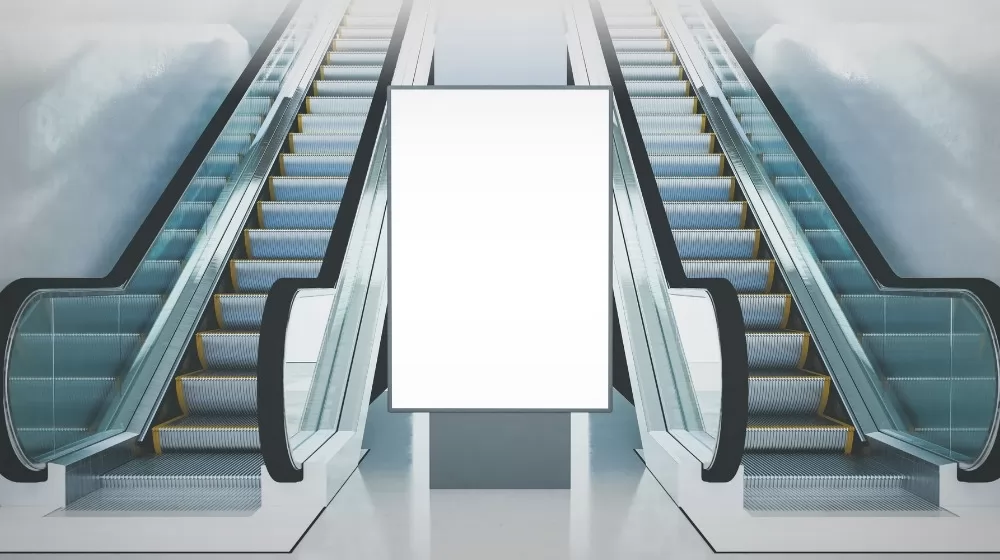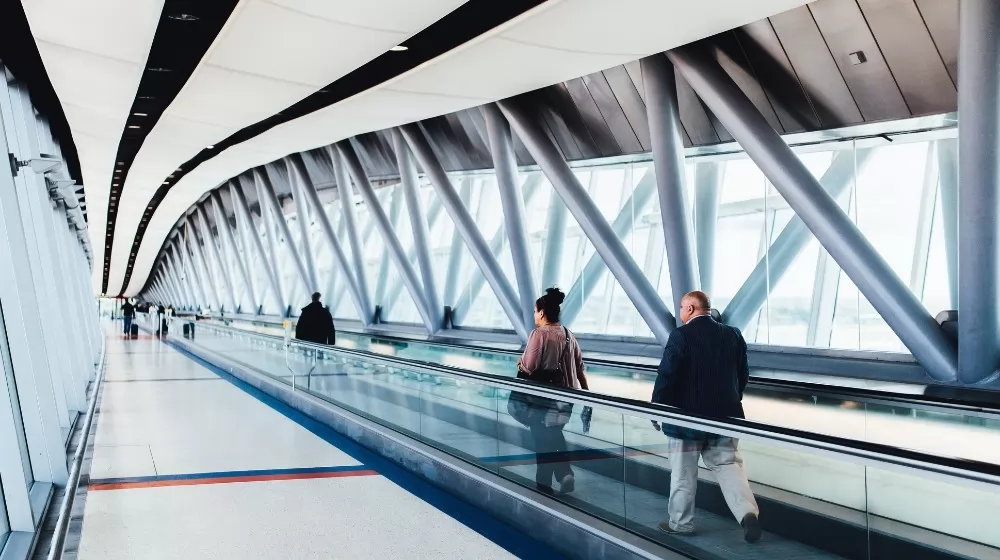
Welcome to an immersive journey into the world of escalators, one of the marvels of modern engineering that have reshaped our urban landscapes. As a leading escalator manufacturer, Hosting Elevator invites you to delve into the fascinating history, mechanisms, and types of escalators that have made vertical transportation efficient and convenient.
1.A Brief History of Escalators
The escalator we know today didn’t appear overnight—it evolved over decades of innovation, driven by inventors and early escalator manufacturers aiming to solve the challenge of moving large crowds efficiently.
1.1 Early Inventions of Escalator Prototypes
Did you know the first escalator-like device was created in 1859? Nathan Ames, an American inventor, patented a "Revolving Stairs" design, but it was never built. It wasn’t until 1891 that Jesse Reno, another American, unveiled the first working escalator prototype—a sloped, moving conveyor belt with wooden slats, installed at Coney Island’s Luna Park. This early model was more of an amusement ride than a practical tool, but it laid the groundwork for modern escalators.
1.2 Evolution of Escalator Design by Manufacturers
By the late 1890s, escalator manufacturers like Otis Elevator Company began refining designs to improve safety and functionality. Otis’s 1899 "Escalator" (the first to use the term) featured interlocking steps and a handrail, addressing two major flaws in early prototypes: unstable platforms and no way for users to steady themselves. Over the 20th century, manufacturers added key upgrades—like metal steps (replacing wood), variable speed controls, and safety sensors—turning escalators into the reliable workhorses we depend on today.
1.3 Key Milestones in Escalator Adoption Globally
The 1920s marked a turning point for escalator adoption: major cities like New York, London, and Paris installed them in subway stations and department stores, proving their value for high-traffic public spaces. By the 1950s, post-war economic growth spurred demand for escalators in shopping malls and airports, with escalator manufacturers expanding production to meet global needs. Today, it’s hard to imagine a busy urban area without at least one escalator—testament to their lasting impact on daily life.

2.Understanding the Basic Mechanism of Escalators
To appreciate the different types of escalators, it helps to first grasp how they work. At their core, all escalators rely on a simple yet sophisticated mechanism to move steps and handrails in sync—something every escalator manufacturer prioritizes in design.
2.1 Core Principles of Escalator Movement
Every escalator operates on the same basic principle: a motor-driven chain system pulls a series of interconnected steps along a track. The track is sloped at a fixed angle (usually 30° or 35°) to balance speed and safety, while a separate drive system moves the escalator handrail at the same speed as the steps—critical for user stability. As a leading escalator manufacturer, we ensure this synchronization is precise: even a small mismatch between steps and handrails can cause trips or falls.
2.2 How Escalator Steps and Handrails Coordinate
Ever wondered how escalator steps stay level as they move up or down? Each step has two sets of wheels: one that follows the main track (moving the step forward) and another that follows a curved "return" track (flipping the step upside down to reset at the bottom). The escalator handrail, meanwhile, is a continuous belt driven by a separate motor linked to the main step drive. This coordination is tested rigorously by escalator manufacturers—we run thousands of cycles during production to ensure no lag or speed variation.
2.3 Role of Power and Control Systems in Escalators
Behind the scenes, escalators depend on two key systems: power and controls. The power system uses an electric motor (often paired with a gearbox to adjust speed) to drive the step chain, while the control system uses sensors and microchips to manage operation. For example, occupancy sensors can slow the escalator during low-traffic times (saving energy), while safety sensors stop it if an object gets stuck. As an escalator manufacturer with full R&D capabilities, we integrate smart control systems into our designs to boost efficiency and safety.
3.Design and Operation of Escalators
Escalator design isn’t one-size-fits-all—escalator manufacturers tailor each unit to the space, traffic volume, and environment it will serve. From ergonomics to operational modes, every detail matters.
3.1 Ergonomic Design Considerations for Escalators
Ergonomics ensures escalators are easy and safe for all users, including children, seniors, and people with mobility aids. Key ergonomic features include:
-
Step depth and height: Standard steps are 400mm deep and 220mm high—wide enough for most shoes, and low enough to prevent tripping.
-
Handrail height: Set at 900mm (from step surface) to accommodate most adults, with a smooth, non-slip surface.
-
Platform size: Top and bottom platforms are at least 1.8m long to give users time to enter/exit safely.
As an escalator manufacturer, we prioritize these details—our designs are tested with diverse user groups to ensure accessibility for everyone.
3.2 Operational Modes of Modern Escalators
Modern escalators offer flexible operational modes to match traffic patterns, a feature escalator manufacturers have refined over decades. Common modes include:
-
Continuous operation: Runs 24/7 (ideal for airports or 24-hour malls).
-
Intermittent operation: Starts when a user approaches (via motion sensors) and stops after a period of inactivity (saves energy for low-traffic areas like office lobbies).
-
Dual-direction operation: Switches direction based on peak hours (e.g., upward in the morning for commuters, downward in the evening).
Our team of escalator manufacturer experts helps clients choose the right mode—we analyze foot traffic data to recommend settings that balance convenience and cost.
3.3 Custom Design Solutions by Leading Escalator Manufacturers
Every space has unique needs: a narrow subway station might require a compact escalator, while a luxury mall might want a custom-colored handrail. Leading escalator manufacturers (like us) offer custom solutions, such as:
-
Adjustable step width: Wider steps (up to 1.2m) for high-capacity areas like stadiums.
-
Weather-resistant materials: For outdoor escalators (e.g., stainless steel steps to resist rust).
-
Branded elements: Custom handrail colors, step lighting, or logo integration for retail spaces.
We’ve designed custom escalators for projects ranging from busy train stations to outdoor tourist attractions—proving that with the right escalator manufacturer, even the most challenging spaces can accommodate an escalator.

4.Key Components of an Escalator
An escalator is only as reliable as its parts—and as an escalator manufacturer that also produces critical components, we know this better than anyone. Below are the core components that keep escalators running smoothly, plus how our parts (like air filters and oil-water separators) enhance performance.
4.1 Structural Components (Steps, Trusses, Handrails)
Structural components form the "bones" of an escalator, supporting weight and ensuring stability.
-
Steps: Made of aluminum or stainless steel (durable and easy to clean), with anti-slip grooves to prevent slips. We manufacture steps in multiple sizes to fit different escalator models.
-
Truss: The metal frame that houses the step chain and track. Our trusses are made from high-strength steel, tested to withstand heavy loads (up to 100kg per step).
-
Handrails: A continuous rubber or polyurethane belt, reinforced with fabric for flexibility. We use UV-resistant materials to prevent fading, even for outdoor escalators.
4.2 Mechanical Components (Motors, Gearboxes)
Mechanical components provide the "muscle" to move the escalator.
-
Motor: Electric motors (typically 5-15kW) that drive the step chain. Our motors are energy-efficient, meeting global standards for low power consumption.
-
Gearbox: Reduces the motor’s speed to a manageable level for the step chain. We use precision-machined gearboxes to minimize noise and wear.
-
Chain and Sprockets: The chain links steps together, while sprockets (toothed wheels) guide the chain along the track. Our chains are treated with anti-corrosion coatings for long life.
4.3 Auxiliary Components (Air Filters, Oil-Water Separators)
Auxiliary components keep the escalator clean and protected—areas where our expertise as an escalator manufacturer shines.
| Component Category | Key Parts | Function | Our Role as an Escalator Manufacturer |
|---|---|---|---|
| Auxiliary | Air filter components | Trap dust and debris from the motor and control system, preventing clogs. | We manufacture high-efficiency air filters tailored to escalator systems, ensuring optimal airflow. |
| Oil-water separators | Remove water and impurities from the gearbox oil, extending oil life and reducing wear. | Our oil-water separators are compact and easy to maintain, designed to fit seamlessly in escalator trusses. | |
| Vacuum regulators | Control air pressure in the brake system, ensuring smooth stops. | We produce precision vacuum regulators that meet strict safety standards. |
These components might seem small, but they’re critical to reducing maintenance costs and extending the escalator’s lifespan—something we emphasize to every client.
5.Classification of Escalators
Escalators are classified by several factors, including direction, inclination, and capacity. Understanding these categories helps you choose the right type for your space—and a knowledgeable escalator manufacturer can guide you through the process.
5.1 Classification by Direction of Movement
The direction an escalator moves is one of the most basic distinctions, and it directly impacts how users flow through a space.
| Type | Direction | Use Case | Why It Matters |
|---|---|---|---|
| Single-direction | Upward only or downward only | Areas with one-way traffic (e.g., a stadium’s upper levels, where most users exit downward after an event). | Prevents congestion by guiding users in a single path. |
| Dual-direction | Switches between upward and downward (via controls) | High-traffic spaces with variable flow (e.g., subway stations: upward in the morning, downward in the evening). | Maximizes efficiency by adapting to peak hours. |
As an escalator manufacturer we often recommend dual-direction models for spaces with fluctuating traffic—they’re more versatile than single-direction options.
5.2 Classification by Angle of Inclination
The angle at which an escalator is sloped determines how much space it takes up and how far it can lift users. The most common angles are set by industry standards, but escalator manufacturers can create custom angles for unique spaces.
-
30° inclination: The shallowest standard angle, ideal for low-rise spaces (e.g., a 2-story mall). It takes up more horizontal space but is slower and more accessible for seniors or those with mobility concerns.
-
35° inclination: The most popular angle for commercial spaces (malls, airports, office buildings). It balances space efficiency and speed—lifting users 6-12 meters while keeping the escalator compact.
-
Custom angles (27°-45°): Rare, but used for specialized needs (e.g., a 40° angle for a steep subway entrance). We only recommend custom angles after a thorough site assessment, as steeper angles can reduce safety.
5.3 Classification by Capacity
Capacity refers to how many people an escalator can move per hour—a key factor for busy spaces. Escalator manufacturers measure capacity based on step width and speed.
| Capacity Level | Step Width | People per Hour (PPH) | Use Case |
|---|---|---|---|
| Low | 600mm | 3,000-5,000 PPH | Small retail stores, office lobbies with low traffic. |
| Medium | 800mm | 6,000-10,000 PPH | Mid-sized malls, hotel atriums. |
| High | 1,000-1,200mm | 12,000-18,000 PPH | Airports, subway stations, large stadiums (e.g., a busy airport terminal during holiday travel). |
Choosing the right capacity is critical—too small, and you’ll have long lines; too large, and you’ll waste energy. Our team as an escalator manufacturer analyzes foot traffic data to recommend the perfect capacity for your space.

6.Specialized Types of Escalators
While standard escalator work for most spaces, some environments need specialized designs. Escalator manufacturers like us create these tailored models to handle unique challenges—from harsh weather to limited space.
6.1 Outdoor Escalators (Weather-Resistant Design)
Outdoor escalators face rain, snow, extreme heat, and dust—so they require heavy-duty, weather-resistant components. Key features of our outdoor escalators include:
-
Stainless steel steps and trusses: Resist rust and corrosion from rain or saltwater (ideal for coastal areas).
-
Heated handrails and steps: Prevent ice buildup in cold climates (critical for safety).
-
Waterproof control systems: Sealed electrical components to protect against rain damage.
We’ve installed outdoor escalators in locations like waterfront malls and tourist attractions—proving that with the right escalator manufacturer, escalators can thrive outside.
6.2 Escalators for Heavy-Duty Environments
Some spaces demand escalators that can handle constant use, heavy loads, or harsh conditions. These heavy-duty models are designed by escalator manufacturers to be tough and low-maintenance. Common heavy-duty environments include:
-
Airports: Escalators here run 24/7, carrying users with luggage. Our airport escalators have wider steps (1,200mm) and reinforced handrails to handle bags.
-
Industrial facilities: Escalators in factories or warehouses need to resist dust and chemicals. We use sealed motors and chemical-resistant paints for these models.
-
Stadiums: During events, stadium escalators see sudden surges in traffic. Our designs include extra safety sensors and high-capacity step chains to handle crowds.
6.3 Compact Escalators for Limited Spaces
Narrow hallways, small lobbies, or historic buildings often have limited space—so escalator manufacturers create compact models to fit. Our compact escalators feature:
-
Slim trusses: Up to 30% narrower than standard trusses, fitting in spaces as tight as 1.5m wide.
-
Shorter platforms: Reduced platform length (1.2m instead of 1.8m) for small lobbies, without compromising safety.
-
Vertical return tracks: Steps fold vertically (instead of horizontally) when returning to the bottom, saving space.
Compact escalators are perfect for older buildings being renovated—they let you add an escalator without major structural changes.
7.Escalator Innovation and Technology
The escalator industry isn’t static—escalator manufacturers are constantly innovating to make escalators smarter, more efficient, and safer. Below are the latest tech trends shaping the future of escalators.
7.1 Smart Escalators with IoT Integration
IoT (Internet of Things) technology is transforming escalators from passive machines to connected systems. Our smart escalators include:
-
Real-time monitoring: Sensors track step speed, handrail alignment, and motor temperature, sending data to a cloud platform. Facility managers can check status remotely—no need for on-site visits.
-
Predictive alerts: If a component (like a gearbox) shows signs of wear, the system sends an alert to our team. This lets us fix issues before they cause breakdowns.
-
User analytics: Sensors count how many people use the escalator, when, and in which direction. This data helps clients optimize operational modes (e.g., switching to dual-direction during peak hours).
As an escalator manufacturer with strong R&D capabilities, we’re leading the charge in IoT integration—making escalators more reliable and cost-effective.
7.2 Energy-Efficient Escalator Designs
Energy costs are a major concern for facility managers, so escalator manufacturers are focused on reducing power consumption. Our energy-efficient escalators include:
-
Regenerative braking: When the escalator is descending (or carrying a heavy load upward), the motor acts as a generator, feeding energy back into the building’s grid. This can reduce energy use by up to 30%.
-
LED lighting: Replacing traditional bulbs with LEDs in step lighting and handrail indicators cuts energy use and lasts longer.
-
Variable speed drives: The escalator slows to 50% speed when no one is using it, then speeds up when a user approaches. This is perfect for office buildings, where traffic drops after hours.
7.3 Predictive Maintenance Technology for Escalators
Gone are the days of "break-fix" maintenance—escalator manufacturers now use predictive technology to keep escalators running. Our predictive maintenance program includes:
-
Vibration analysis: Sensors detect unusual vibrations in the motor or gearbox, which signal wear.
-
Oil analysis: We test gearbox oil regularly to check for impurities (a sign of component damage).
-
Remote diagnostics: Our team can access the escalator’s control system remotely to troubleshoot issues, reducing downtime.
This approach cuts maintenance costs by 25% on average—and ensures escalators are always safe for users.
8.Escalator Safety
Safety is non-negotiable for any escalator manufacturer—escalators handle millions of users yearly, so every design and maintenance step must prioritize protection. Below are the key safety features and practices to look for.
8.1 Mandatory Safety Features for Escalators
All reputable escalator manufacturers include mandatory safety features to prevent accidents. These include:
-
Emergency stop buttons: Red buttons located at the top and bottom platforms, which stop the escalator immediately if there’s a problem.
-
Step demarcation strips: Yellow strips on the edge of steps, which alert users to the step edge and prevent feet from getting caught.
-
Handrail entry guards: Covers at the top and bottom of the handrail that prevent fingers or clothing from being pulled into the mechanism.
-
Overload sensors: Stop the escalator if it’s carrying too many people (prevents chain or motor damage).
Our escalators meet or exceed global safety standards (like EN 115 in Europe and ASME A17.1 in the U.S.)—we test every safety feature before installation.
8.2 Regular Maintenance as a Safety Priority
Even the safest escalator needs regular maintenance—and as an escalator manufacturer that also offers maintenance services, we know how critical this is. Our maintenance checks include:
-
Inspecting step chains and sprockets for wear or damage.
-
Cleaning and replacing air filter components to prevent motor overheating.
-
Testing emergency stop buttons and safety sensors to ensure they work.
-
Lubricating the gearbox and checking oil levels (using our oil-water separators to keep oil clean).
We recommend monthly inspections for high-traffic escalators (like airports) and quarterly inspections for low-traffic ones—this keeps safety risks to a minimum.
8.3 User Safety Guidelines for Escalator Use
While escalator manufacturers design for safety, users also play a role. Simple guidelines can prevent most accidents:
-
Hold onto the handrail at all times (especially important for children and seniors).
-
Keep feet away from the edge of steps (the yellow demarcation strip is a warning!).
-
Don’t run, jump, or sit on steps—these actions increase the risk of falls.
-
Avoid using strollers, wheelchairs, or large luggage on escalators (use elevators instead, if available).
We help clients share these guidelines by providing signage and digital displays near escalators—education is key to safe use.

9.Escalators Around the World
Escalators are a global phenomenon, but escalator manufacturers adapt designs to fit regional needs, climates, and cultural preferences. Below are some examples of how escalators vary worldwide.
9.1 Iconic Escalator Installations Globally
Some escalators have become landmarks in their own right—testaments to the creativity of escalator manufacturers and architects.
-
Central-Mid-Levels Escalator (Hong Kong): The longest outdoor covered escalator system in the world (800m long), connecting Hong Kong’s Central and Mid-Levels neighborhoods. We supplied components for its 2018 renovation, including weather-resistant handrails.
-
Palais Royal-Musée du Louvre Escalator (Paris): A glass-and-steel escalator in the Louvre’s underground lobby, designed to blend with the museum’s historic architecture. Its compact design (by a European escalator manufacturer) fits in the tight space while handling thousands of tourists daily.
-
CNN Center Escalator (Atlanta, U.S.): A 8-story escalator with a glass enclosure, one of the tallest in the U.S. It’s a popular tourist spot, thanks to its dramatic design.
9.2 Regional Preferences in Escalator Types
Different regions have unique needs that escalator manufacturers must address:
-
Asia: High-density cities like Tokyo and Shanghai demand high-capacity escalators (12,000+ PPH) for subways and malls. Dual-direction models are also common, as traffic flows shift drastically during rush hour.
-
Europe: Historic cities (like Rome or Prague) often require compact escalators that fit in older buildings. Outdoor escalators here also need to resist cold winters, so heated steps are a popular add-on.
-
Middle East: Extreme heat (up to 50°C) means escalators need heat-resistant components. Our Middle East clients often choose stainless steel steps and UV-protected handrails to withstand the sun.
9.3 Challenges of Escalator Installation in Diverse Climates
Installing escalators in extreme climates requires expertise from escalator manufacturers—here are some common challenges and solutions:
-
Cold climates (Canada, Scandinavia): Frozen steps and handrails are a risk. We install heated steps and handrails, plus insulated trusses to protect electrical components.
-
Humid climates (Southeast Asia, Brazil): Moisture can cause rust and electrical issues. Our escalators use corrosion-resistant materials and dehumidifiers in control cabinets.
-
High-altitude areas (Tibet, Colorado): Thin air reduces motor efficiency. We modify motor designs to work at high altitudes, ensuring consistent performance.
10.Escalators and Urban Planning
Escalators aren’t just machines—they’re critical to urban planning, shaping how people move through cities and use public spaces. Escalator manufacturers work closely with urban planners to create efficient, sustainable cities.
10.1 Role of Escalators in Public Transit Hubs
Public transit (subways, train stations, airports) relies on escalators to move large crowds quickly. For example:
-
A busy subway station during rush hour might have 4-6 high-capacity escalators (1,200mm steps) to handle 50,000+ commuters per hour.
-
Airports use escalators to connect terminals, gates, and baggage claims—our airport clients often request escalators with wide steps to accommodate luggage.
As an escalator manufacturer, we collaborate with transit authorities to design escalator layouts that reduce congestion. For example, placing escalators at the end of platforms (instead of the middle) can prevent bottlenecks.
10.2 Escalators as a Catalyst for Commercial Space Efficiency
Malls and retail centers use escalators to boost foot traffic and sales. Here’s how:
-
Vertical connectivity: Escalators link different floors, encouraging shoppers to explore upper levels (which often have lower foot traffic).
-
Space optimization: Unlike elevators, escalators don’t require waiting areas—they take up less floor space while moving more people.
-
Visual appeal: Custom escalators (with glass sides or LED lighting) can become focal points, attracting customers and enhancing the shopping experience.
Our team as an escalator manufacturer helps retailers design escalator layouts that maximize sales—for example, placing escalators near popular stores to drive traffic to other areas.
10.3 Sustainable Escalator Integration in Smart Cities
Smart cities prioritize sustainability, and escalator manufacturers are part of this movement. Our sustainable escalator solutions include:
-
Energy recovery: Regenerative braking systems feed energy back into the grid, reducing a building’s carbon footprint.
-
Recyclable materials: We use aluminum and stainless steel (both fully recyclable) in steps and trusses, minimizing waste.
-
Solar power integration: For outdoor escalators, we can install solar panels to power lighting or auxiliary systems (like heated handrails).
Cities like Singapore and Copenhagen are already using these sustainable escalators in their smart city plans—proving that efficiency and sustainability can go hand in hand.
Conclusion
From their historical origins to the cutting-edge innovations of the present day, escalators have truly transformed our urban environments. As an esteemed escalator manufacturer, Hosting Elevator is proud to be part of this transformative journey. We are committed to driving innovation, enhancing safety, and promoting sustainable practices in the escalator industry. Visit our website at www.hosting-elevator.com to explore our extensive range of escalator solutions.
Read More:


